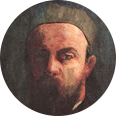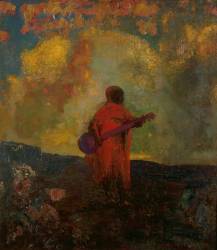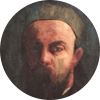Odilon Redon drawings & artprints
A precursor of Symbolism, Odilon Redon left his mark on art history with drawings, engravings and paintings featuring dreamlike, surrealist themes. First in the period of his life known as the "blacks", in the second half of the 19th century, then in a second part of his career giving way to colour, at the beginning of the 20th century, the French painter devoted his life to the creation of an imaginary world, black then coloured, but still fantastic, which seduced his contemporaries and inspired his successors to follow the path of surrealism and fauvism, placing him among the great painters of his time in France and Europe.
Discover the finest works by Odilon Redon, the master of French symbolism, with his charcoal drawing "The Smiling Spider", representing a hybrid being straight from a fantastic world, the panel "Décoration Domecy: grand panneau à décor végétal", from his decorations for the château of his patron Pierre de Domecy, or his painting "The Buddha", one of his works echoing his strong interest in spiritualism brought by religion.
Treat yourself to a reproduction of Odilon Redon available in the catalogue, and discover his life with the biography, outlining the life of one of the most innovative artists of the late 19th and early 20th centuries.
Biography of Odilon Redon
The beginnings of Odilon Redon: a youth devoted to art
Odilon Redon, whose real name was Bertrand Redon, was born in Bordeaux in 1840. Raised in the Gironde countryside, on the Peyrelebade estate, he quickly developed a passion for drawing, taking up charcoal at the age of 6. With a definite talent for art, his family supported his artistic education, and in 1855 he studied French painting, academic drawing and watercolour techniques, and engraving with Stanislas Gorin, in particular the works of Delacroix, painter and engraver Camille Corot, painter and sculptor Gustave Moreau, and pastellist Jean-François Millet, who was a great inspiration to the followers of the Impressionist style. In 1857, Odilon Redon moved to Paris to study architecture. His apprenticeship did not go as planned, however, and he ended up failing the Ecole des Beaux Arts competition, as the Académie des Beaux Arts was a prerequisite for becoming an architect. However, the budding young artist from Bordeaux made the most of his time in Paris to discover the writers Flaubert, Edgar Allan Poe and the work of the poet Baudelaire, for whom he illustrated several poems from the "Fleurs du mal". In 1865, he returned to Bordeaux, and it was with Rodolphe Bresdin, an artist of fantastic works, that Odilon Redon, although not yet fully rooted in symbolism, moved towards this path as he learned engraving and perfected his technique.
Odilon Redon's "black" period
In 1870, the start of Odilon Redon's career was cut short by the Franco-Prussian war, in which he was mobilised as a soldier. On his return, he settled in Paris, in the Montparnasse district, and produced a whole series of avant-garde works, with black and white compositions ranging from lithographs to charcoal. Inspired by Rodolphe Bresdin, and far removed from traditional painting, he used what he called his "noirs" to convey an exaggerated expressionism, attempting to transcribe the deepest recesses of his unconscious. In 1880, Odilon Redon married Camille Falte, with whom he had two children, Jean and Arï. However, Jean, his first son, died only 6 months after his birth. Until 1895, the Bordeaux artist continued to paint and engrave in a pictorial style that inspired decadence in the art critics of the time. Nevertheless, his work had a lasting impact on the artistic milieu of the period, and many writers and poets, such as Mallarmé and Huysmans, were inspired by Odilon Redon's dreamlike work. In 1886, Odilon Redon was even invited to exhibit at the last Impressionist painters' exhibition in Paris, which opened its doors for the first time to the Post-Impressionist movement, alongside Impressionist paintings by Paul Gauguin, Camille Pissarro and Edgar Degas.
Odilon Redon's transition to colour
At the end of the century, a new page was turned for Odilon Redon. Doubtless influenced by Paul Gauguin and pure colour, and also by a more optimistic way of thinking, the Symbolist painter's works were presented as a biography of the moment, with the arrival of coloured hues replacing the blacks that had made up the majority of his work in the first part of his career. The painter thus turned to the use of pastels, always in the production of fantastic themes linked to dreams, in order to retranscribe the effects of light that already existed in the design and production of his blacks. While most painters of the time were making their mark with oil on canvas, it was with the use of coloured pastels that Odilon Redon began to make a name for himself as a colourist, in the late 19th and early 20th centuries. While continuing his esoteric work, with colours far removed from the usual realism, he was called upon to travel between Paris and Domecy-sur-le-Vault, to paint decorative paintings for the Hôtel Particulier of his friend Ernest Chausson, or works from his imagination, to decorate the château of his patron Pierre de Domecy.
Odilon Redon, a painter recognised by his peers
Previously considered decadent by many critics, Redon's work was now widely acclaimed by the artistic and intellectual milieu of the early 20th century, and Odilon Redon was seen as a precursor and one of the major artists of the period. Like Impressionist painting, which was the major trend at the end of the previous century, Odilon Redon's personal and interpretative work, in keeping with the pictorial trend of post-Impressionism, breathed new life into French and European painting. After presenting a number of works, first in black and then in colour, in museums and exhibitions in Paris and Europe, his work was even exhibited across the Atlantic, in New York and then in Chicago, the new strongholds of art in the world, via a catalogue of his lithographs. Odilon Redon died in 1916, after a career teeming with unique works that paved the way for a new vision of painting and art.
The legacy of Odilon Redon
Considered to be one of the precursors of the Symbolist artistic movement and the Surrealist pictorial movement, with themes imbued with mysticism, melancholy, legends and a poetic aspect, Odilon Redon's idealism struck a chord by completely disregarding academicism and incorporating the transposition of a dream idealism into his work. Science, music, historical legends and religion had a real influence on the painter, a leading figure among the Symbolists. These recurring themes can be seen in his mythological canvases, such as his oil on canvas "The Chariot of Apollo" or "The Birth of Venus", as well as in his numerous engravings and paintings of cyclops, his religious paintings such as "Saint Sebastian" or "The Buddha", on display at the Musée d'Orsay, and his representations of nature using surrealist hues or charcoal drawings of humanoid spiders. Odilon Redon thus paved the way for new artistic movements in modern art, notably abstract and surrealist painting, and Fauvism, which was championed by artists such as Henri Matisse, Pierre Bonnard and, indirectly, Edvard Munch. Despite his popularity, Odilon Redon's work was rarely brought to the attention of the general public. In recent years, however, there have been an increasing number of retrospectives, such as the one held at the Grand Palais in Paris in 2011, and his lithographs, paintings, pastel and charcoal works can also be admired in many museums around the world. He is featured in the exhibition catalogue of the Musée des Beaux Arts in Bordeaux, in the collections of the Musée d'Orsay and the Musée du Louvre in Paris, in the collection of the Metropolitan Museum of Art in New York, and at the Artizon Museum in Tokyo, among others.











































